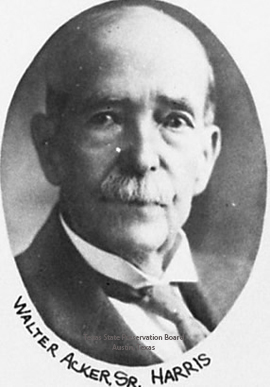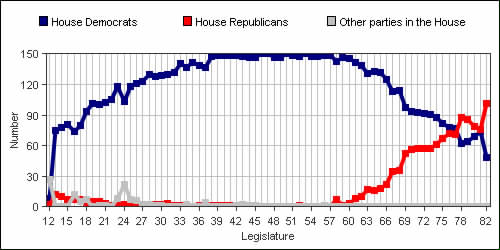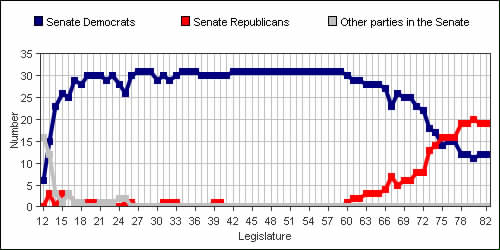The library frequently fields questions about the history of the Legislature and the often-colorful individuals who have held office.
 Since statehood, 5,451 people have served in the Texas Legislature. Most didn't serve for very long, particularly during the 19th century. The average length of consecutive service by House members is slightly under four years; Senators' average tenure is closer to five years.
Since statehood, 5,451 people have served in the Texas Legislature. Most didn't serve for very long, particularly during the 19th century. The average length of consecutive service by House members is slightly under four years; Senators' average tenure is closer to five years.
The difficulty of travel may have contributed to high turnover. Consider Henry Warren, elected to the 11th Legislature from El Paso, who took so long to make the journey to Austin that he arrived after the Legislature had adjourned. (The Texas Senate: Volume II, Civil War to the Eve of Reform, 1861-1889)
It's not clear if Henry Warren would have been eligible to serve if he had arrived on time; the roster of members in the Senate Journal notes that he was "In'igible, too young." At the time, Senators were required to be at least 30 years old. (Constitution of 1866, Article III, § 10, Texas Constitutions Digitization Project)
 The youngest senator ever was Temple Houston, son of Sam Houston. As a young man, he built a reputation as a brilliant speaker, a talented lawyer, and a quick draw with a pistol. Temple Houston took the oath of office on January 13, 1885, when he was only 24 years old.
The youngest senator ever was Temple Houston, son of Sam Houston. As a young man, he built a reputation as a brilliant speaker, a talented lawyer, and a quick draw with a pistol. Temple Houston took the oath of office on January 13, 1885, when he was only 24 years old.
No one challenged his qualifications, although Article III § 6 of the Texas Constitution required senators to be at least 26 years of age. (Constitution of 1876, Article III, § 6, Texas Constitutions Digitization Project)
Homer Hendricks, sworn in eight days shy of his 21st birthday, is the youngest person to have served in the House of Representatives.

Doyle Willis retired from the Legislature after 42 years at the age of 89, making him the oldest person to have served in the Legislature.
The record for longest service belongs to A.M. Aikin, Jr., who served more than 45 years in the House and Senate.
Tom Craddick, who has served since 1969, holds the record for longest service in the House of Representatives.

 It is not uncommon for Legislators to serve non-consecutive terms, but Walter P. Acker, Sr., stands out for the length of time between his terms. His first term, during the 18th Legislature, ended in 1885; 40 years later, he became a member of the 39th Legislature.
It is not uncommon for Legislators to serve non-consecutive terms, but Walter P. Acker, Sr., stands out for the length of time between his terms. His first term, during the 18th Legislature, ended in 1885; 40 years later, he became a member of the 39th Legislature.
Much had changed in Texas during Acker's time away from the Legislature, but the partisan makeup of the Legislature had hardly budged.
In the middle of the 19th century, legislators claimed a wide range of political affiliations, including such unfamiliar labels as Loco Foco, Nullifiers, Tyler man, Polk man, and Tariff man.
From the end of Reconstruction in 1876 until the middle of the 20th century, the Democratic Party monopolized the Legislature. In the 1960s, the Republican Party began a rapid rise, gaining a majority in the Senate in 1997 and the House in 2003.:


If you are interested in broad trends, like the shifting partisan makeup, or facts about an individual, the answers can often be found in the Texas Legislators: Past & Present database, which documents the service of all members back to 1846.

